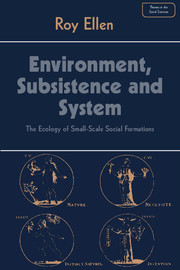Book contents
- Frontmatter
- Contents
- Preface
- Acknowledgements
- 1 ENVIRONMENTAL DETERMINISM AND CAUSAL CORRELATION
- 2 POSSIBILISM AND LIMITING FACTORS
- 3 CULTURAL ECOLOGY AND THE EXPLANATORY IMPERATIVE
- 4 HUMAN ECOLOGY AND THE BIOLOGICAL MODEL
- 5 THE FLOW OF ENERGY AND MATERIALS
- 6 ECOSYSTEMS AND SUBSISTENCE PATTERNS I
- 7 ECOSYSTEMS AND SUBSISTENCE PATTERNS II
- 8 SYSTEMS AND THEIR REGULATION
- 9 INFORMATION AND THE MANIPULATION OF THE ENVIRONMENT
- 10 ADAPTATION: A SUMMARY AND RECONSIDERATION
- 11 THE REPRODUCTION AND EVOLUTION OF SOCIAL AND ECOLOGICAL SYSTEMS
- 12 ECOLOGY IN ANTHROPOLOGICAL METHOD AND THEORY
- Notes
- Bibliography
- Name Index
- Subject Index
5 - THE FLOW OF ENERGY AND MATERIALS
Published online by Cambridge University Press: 05 June 2012
- Frontmatter
- Contents
- Preface
- Acknowledgements
- 1 ENVIRONMENTAL DETERMINISM AND CAUSAL CORRELATION
- 2 POSSIBILISM AND LIMITING FACTORS
- 3 CULTURAL ECOLOGY AND THE EXPLANATORY IMPERATIVE
- 4 HUMAN ECOLOGY AND THE BIOLOGICAL MODEL
- 5 THE FLOW OF ENERGY AND MATERIALS
- 6 ECOSYSTEMS AND SUBSISTENCE PATTERNS I
- 7 ECOSYSTEMS AND SUBSISTENCE PATTERNS II
- 8 SYSTEMS AND THEIR REGULATION
- 9 INFORMATION AND THE MANIPULATION OF THE ENVIRONMENT
- 10 ADAPTATION: A SUMMARY AND RECONSIDERATION
- 11 THE REPRODUCTION AND EVOLUTION OF SOCIAL AND ECOLOGICAL SYSTEMS
- 12 ECOLOGY IN ANTHROPOLOGICAL METHOD AND THEORY
- Notes
- Bibliography
- Name Index
- Subject Index
Summary
INTRODUCTION
A great deal of our contemporary knowledge of the operation of ecosystems is based on the early work of Raymond L. Lindeman (1942). Drawing on the studies of Charles Elton in England and those of Clements and Shelford in the United States, Lindeman focussed on the fixation of energy by natural ecosystems and the quantitative relations that must theoretically exist between different users of energy as it is progressively disseminated among the various populations of organisms in an ecosystem. This concentration on the movement of energy and materials through a system was to consolidate ecology as a discipline and field of study; and it is the ecosystem approach which, over the past decade, has had most influence on the work of anthropologists interested in the articulation of biological and social systems. In this chapter I take up some of the general and theoretical concerns related to this approach, and in Chapters 6 and 7 specify the relevance of such ideas and techniques to an understanding of subsistence arrangements in particular.
Populations of organisms interact to form food webs, biotic communities and ecosystems. They are linked by flows of energy and nutrient materials which may be described and measured in quantitative terms. Although the complexity of ecosystems prevents a complete mapping of such flows, their examination in broad terms and the tracing of specific pathways enables us to learn much about the relationships between various components of the system and its overall structure.
- Type
- Chapter
- Information
- Environment, Subsistence and SystemThe Ecology of Small-Scale Social Formations, pp. 95 - 122Publisher: Cambridge University PressPrint publication year: 1982



